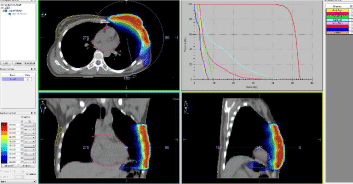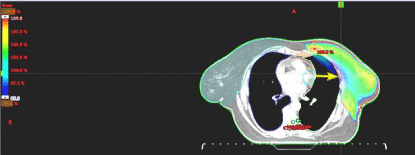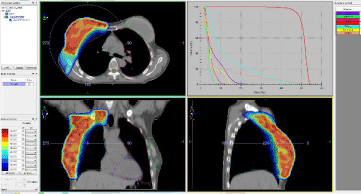
Research Article
Austin J Med Oncol. 2021; 8(1): 1058.
Radiotherapy after Breast-Preserving Surgery for Early Breast Cancer-Basic Principles and Our Experience
Marinova L¹*, Petrova K¹ and Evgeniev N²
¹Department of Radiotherapy, Oncology Hospital, Bulgaria
²Department of Medical Oncology, Oncology Hospital, Bulgaria
*Corresponding author: Lena Marinova, Department of Radiotherapy, Oncology Hospital, Bulgaria
Received: February 09, 2021; Accepted: March 09, 2021; Published: March 16, 2021
Abstract
Breast cancer is the second most common malignant tumor worldwide and the most common oncological disease among women. This article presents our experience in postoperative Radiotherapy (RT) in 341 patients with Early Breast Cancer (EBC) after Breast-Preserving Surgery (BPS). Emphasis is placed on the indications and Clinical Target Volumes (CTV) for radiotherapy.
The significant effect of postoperative RT in terms of Local Tumor Control (LTC), long-term recurrence-free survival and overall survival is reported. The main goal of this article is to establish high-tech radiotherapy after BPS in early BC as the main local method, optimizing the treatment and cosmetic results.
Keywords: Early breast cancer; Breast-preserving surgery; High-tech radiotherapy; Treatment results; Cosmetic results
Introduction
Breast Cancer (BC) is the second most common malignancy in the world and the most common cancer among women [1]. In 2018 the number of new cases of breast cancer reached nearly 2.1 million, which is 24.2% of newly diagnosed women with cancer or 11.6% of all new cases. BMD is the fifth most common cause of death in women with cancer, i.e. 627,000 deaths or in 15% the main cause of death. In well-developed countries, the prognosis of new cases is relatively good [2]. In recent years, there has been a significant rejuvenation of new BC cases, a fact that defines breast cancer as a socially significant cancer. Breast-Preserving Surgery (BPS) with a volume of quadrantectomy was introduced in Bulgaria in the 80s of the last century. The insufficiently studied effect of postoperative radiotherapy after BPS in terms of Local Tumor Control (LTC), distant recurrence and overall survival, as well as cosmetic results, was justified in 2000. In Bulgaria to defend two candidate dissertations [3,4]. The longterm Bulgarian radiotherapeutic experience reported healing results comparable to the world ones [3,4].
Materials and Methods
The prospective study for the period 1987-2000 included 341 women with early breast cancer (EBC)-I and II clinical stage after BPS with a volume of quadrantectomy or sectoral resection and axillary lymph dissection. After completion of RT, the mean followup period was 6.5 years (maximum -11.5 years and minimum -1.5 years). In all EBC, postoperative 3D Conformal Radiotherapy (3D CRT) with 60Co in a whole breast Clinical Target Volume (CTV) with a Daily Dose (DD) 2 Gy up to Total Dose (TD) 50 Gy was performed. Following randomization, 120 patients underwent Boost RT in the tumor bed with a Daily Dose (DD) 2 Gy up to TD 60 Gy. Followed by Chemotherapy (Ch), in cases with pN1, regional RT at the three levels of Axillary Lymph Nodes (ALN) up to 50 Gy, was performed. In hormonally positive tumors, antiestrogenic hormone therapy for a period of 3-5 years was prescribed.
The prospective study was performed according to the following radiotherapy principles
In the absence of metastatic axillary lymph nodes/pN0: Whole Breast RT (WBRT) with or without Boost RT (with high-energy photons, electrons or brachytherapy) in the tumor bed or partial RT of selected patients.
In 1-3 metastatic axillary lymph nodes: WBRT with or without Boost RT (with high-energy photons, electrons or brachytherapy) in the tumor bed. Despite insufficient observations and reported results, RT of supra and subclavian LNs is highly recommended. In tumors in the inner quadrants of the breast, G3 and negative hormonal status, assessment for RT of parasternal LNs is recommended.
In more than 4 metastatic LNs: WBRT with or without Boost RT in the tumor bed, as well as regional RT of the supra and subclavian LNs. In medial tumors pT2, G3 and negative hormonal status, RT of parasternal LNs is recommended.
In case of indication for Ch after BPS: Of early breast cancer, the postoperative RT is performed after Ch.
Treatment results after complex treatment of early breast cancer
Local Recurrences (LR): After radiotherapy of the whole breast with or without Boost RT 3.5% local recurrences (in 12 of 341 patients) were reported.
Local Tumor Control (LTC): In a random selection for Boost RT in the tumor bed, we did not report a significant difference between LTC in patients with or without Boost (100% / 99.7%).
Distant Metastases (M1): In 341 patients 6.7% distant metastases (23 of 341 patients) were reported. The analysis of distant metastases shows:
• 1/3 of the M1 patients are at a young age <45 years with breast cancer pT2 (tumor with a diameter of 2 up to 3 cm).
• Half of the metastatic carcinomas are pN1, G3 and with negative hormonal status.
• The reported risk time periods for hematogenous metastasis are up to the second and after the fourth year after the complex treatment.
Disease-Free Survival (DFS): In early breast cancer after complex treatment depending on pN status: 83% 5-year DFS in patients with pN1, and 10-year DFS in patients with pN0 were reported.
Cosmetic results after complex treatment: The following factors are considered to worsen the cosmetic results: pT2-tumor with a diameter of 3cm (p=0.008), large by breast volume/over 100cm3 (p=0.0002), inhomogeneous radiation dose distribution in the entire residual breast/over +12% (p=0.005), adjuvant Ch following postoperative RT (p=0.04).
Quality of life after BPS and postoperative RT: By assessing the quality of life in 341 patients, we found that RT after BPS does not worsen the quality of life.
Conclusions from our prospective study after quadrantectomy of early breast cancer for the period 1987-2000
• After quadrantectomy of early breast cancer with subsequent RT, 5 significant risk factors for local recurrence were demonstrated-G3 (Figure 1), pN1, tumor necrosis, lymphatic vascular infiltration and tumor metaplasia (Figure 2).

Figure 1: Photomicrography of lymphoepithelioma-like breast cancer-high
proliferative index Ki 67 over 50%: x20.

Figure 2: Photomicrography of apocrine breast cancer. A) Positive PAS
reaction of tumor cells of adenosis with apocrine metaplasia: x10; B) Positive
PAS reaction of large tumor cells with abundant granular eosinophilic
cytoplasm and large round nuclei: x40.
• After quadrantectomy, Boost RT in the tumor bed up to TD 60 Gy is required in case of worsening LTC factors: pT2, G3 and negative hormonal status.
• Significant risk factors for distant metastases after complex treatment of breast cancer were demonstrated: tumor 2-3 cm in diameter, G3, pN1, negative hormonal status, tumor necrosis, tumor invasion in blood vessels and tumor metaplasia.
• Significantly worsened relapse-free survival after complex treatment of G3 tumors and negative hormonal status (p<0.01) was reported.
• Large breasts (over 100cm3) was the reason for unsatisfactory cosmetic results after quadrantectomy with subsequent RT.
• In case of large mammary glands (over 100cm3) after RT of the entire residual breast (Figure 3), unsatisfactory cosmetic results, due to radiation inhomogeneity (over +12%) were reported (Figure 4). That fact was the basis for determining large breasts as a relative contraindication for BPS with a volume of quadrantectomy.

Figure 3: Radiotherapy of the left mammary gland with IMRT-VMAT
technique with DD 2 Gy to TD 50 Gy in 25 fractions.

Figure 4: Radiotherapy of the left mammary gland with IMRT-VMAT
technique with DD 2 Gy to TD 50 Gy in 25 fractions.
After 2000, high-tech radiotherapy equipment/linear accelerators were introduced in Bulgaria, through which it is possible to optimize the radiotherapy after breast-preserving surgery for early breast cancer. In radiotherapy of the whole breast CTV includes the residual parenchyma of the mammary gland after localization CT of the chest. The goal is the maximum homogeneous distribution of the radiation dose in the breast at minimum radiation doses in the adjacent normal tissues and organs. It is achieved by high-tech radiation therapy equipment (linear accelerators) after application of a number of radiation techniques such as 3D conformal RT (Figure 5), intensively modulated RT (Figure 6), intensively modulated RT by the VMAT method (Figure 7), and for the left breast- RT techniques with Respiratory Gating (RG), like enhanced inspiration gating and Deep-Inspiration Breath Hold (DIBH) (Figure 8). The radiation dose in the whole breast is up to TD 45-50 Gy with DD 1.8-2 Gy or up to TD 42, 5 Gy with DD 2.66 Gy.

Figure 5: Radiotherapy of the right breast and regional lymph nodes with 3D
CRT technique with DD 2 Gy to TD 50 Gy in 25 fractions.

Figure 6: Radiotherapy of the right breast and regional lymph nodes with
Intensively Modulated RT technique with DD 2 Gy to TD 50 Gy in 25 fractions.

Figure 7: Radiotherapy of the left breast with Intensively Modulated RT
technique by the VMAT method with DD 2 Gy to TD 50 Gy in 25 fractions.

Figure 8: Dose distribution V95% at Deep-Inspiration Breath Hold (DIBH)
Radiotherapy of the left breast by the 3D CRT technique with DD 2 Gy to TD
50 Gy in 25 fractions.
Boost in the tumor bed is required for adverse factors with a high risk of local recurrence: patients <50 years, pN1, lymphatic vascular infiltration and borderline resection lines. Own observations of Boost RT in the tumor bed after quadrantectomy report its significance in pT2/G3 tumors with negative hormonal status. Tumor Boost is performed by high-energy photons (Figure 9). In conventional fractionation, radiation doses up to TD 10-16 Gy with DD 2 Gy/5 times a week, are offered.

Figure 9: Radiotherapy of the left breast and Boost RT in the tumor bed
with IMRT technique by the VMAT method with DD 2 Gy to TD 50 Gy in 25
fractions.
Postoperative CTV of the regional lymphatic nodules is defined by CT planned RT. It is known, that the depth of the anatomical localization of the regional Lymph Nodes (LNs) (subclavian, supraclavicular and axillary) in each person is individual. The parasternal LNs are not visualized on a CT image, which requires identification of the parasternal mammary arteries and veins along which the LNs are located. The postoperative regional radiation dose is TD 50-50.4 Gy with DD 1.8-2 Gy with an estimate for Boost of the operative scar with DD 2 Gy up to TD 60 Gy/5 times per week (Figure 10). In clinical, imaging and pathohistological data for metastatic parasternal LNs, their inclusion in the volume of the postoperative regional RT is necessary. The maximum reduction of the radiation dose in the heart and lungs requires CT planned regional RT in all cases requiring RT of parasternal LNs.

Figure 10: Radiotherapy of the right breast and regional lymph nodes with
IMRT technique by the VMAT method with DD 2 Gy to TD 50 Gy in 25
fractions.
Discussion
Prospective and multicenter studies have shown equivalent treatment outcomes in early breast cancer (stage I-II) after mastectomy with axillary lymph dissection and after BPS with volume of lumpectomy, axillary dissection and postoperative radiotherapy [5-8]. Planned computed tomography Radiotherapy (RT) provides optimal radiation dose in postoperative Clinical Target Volume (CTV) (whole breast or tumor bed) with simultaneously minimized radiation dose to critical organs lung and heart (Figure 5-8). The optimal postoperative RT is Intensively Modulated RT (IMRT) [9]. Postoperative RT in EBC/pN0 of the whole breast up to Total Dose (TD) 50 Gy in 25 fractions for a period of 35 days or up to TD 42.5 Gy in 16 fractions for 22 days achieves similar disease-free and overall survival [10]. Contraindications for breast-preserving surgery are the following: a) After RT with medium or high radiation doses in the residual parenchyma of the breast or RT of the chest wall; b) In case of compulsory RT during the pregnancy; c) In mammographic diffuse calcifications, significant for malignancy; d) In case of locally advanced disease; e) In case of positive tumor cells surgical Resection (R1). f) In early breast cancer after BPS, a number of studies as a risk factor for homolateral recurrences a young age was defined [11-14]. From our prospective study, we reported 5 significant pathohistological risk factors associated with local recurrence after quadrantectomy of early breast cancer with subsequent RT - G3 (Figure 1), pN1, tumor necrosis, lymphatic vascular infiltration and tumor metaplasia (Figure 2) (4). The reported 3.5% local recurrences (in 12 of 341 patients) after whole breast RT with or without Boost RT substantiate the following conclusions: a) 58% of patients with LR are from the breast cancer group with 1 to 3 metastatic lymph nodes/pN1. b) A risk period for development of LR until the second year after the complex treatment was reported (4). c) The thesis of Veronesi U [8] and Fisher B [7] regarding the lack of significant influence of LR on the overall survival of patients is confirmed. The lack of Boost in the tumor bed after PBS has a significant adverse effect on LTC in patients with pT2 (p=0.01), G3 (p=0.0000) and at negative hormonal status (p=0.0068) (4). Randomized trials have been demonstrated a significant reduction in Local Recurrences (LR) after overdose in the tumor or in the tumor bed (boost RT) with high-energy photons, brachytherapy or electrons [15,16].
Boost RT is effective in early BC/pN1, presence of Lymphatic Vascular Invasion (LVI) and/or borderline resection lines. After boost RT, the EORTC study in 1729 patients with tumor cell-positive resection lines reported a significant reduction in LR over a ten-year period (4% vs. 13%; p=0.0001). Boost RT in negative resection lines does not significantly reduce LR [17]. Our conclusions regarding LTC after quadrantectomy with Boost RT up to TD 60 Gy are the following: a) LTC significantly deteriorated after the third year, despite Boost RT in patients with pN1 (p <0.001). b) Despite the complex treatment LTK significantly worsens in high-grade G3 carcinomas and in negative hormonal status/negative estrogen and progesterone receptors. c) After RT of the regional lymph nodes in patients with pN1, no axillary recurrences were observed. d) The lack of Boost in the tumor bed after PBS has a significant adverse effect on LTC in patients with pT2 (p=0.01), G3 (p=0.0000) and at negative hormonal status (p=0.0068) (4).
A randomized study NCIC-CTG MA.20 of the entire breast after lumpectomy with or without Regional Lymph Nodes (RLNs) RT has been conducted. After RT of RLNs at a mean 62-month followup period, a reduction in locoregional recurrences (p=0.02) with increased Disease-Free Survival (DFS) (p=0.003) and Overall Survival (OS) (p=0.07) was reported [18]. In our prospective study after RT of the regional lymph nodes in patients with pN1, no axillary recurrences were observed (4). In young early breast cancer patients after BPS and after mastectomy, similar DFS and OS has been reported [19]. In selected patients after BPS, accelerated partial radiotherapy with RT of the tumor bed without RT of the whole breast has been offered [20]. After Accelerated Partial Radiotherapy (APRT), Local Tumor Control (LTC), similar to that after standard RT of the entire residual breast was achieved [14]. For partially accelerated RT, according to ASTRO, patients =60 years of age, in the absence of a BRCA1/2 mutation, estrogen receptor positive tumors in stage I /pT1N0, with clean resection lines (R0 resection), and those without multifocal spread in the breast, were appropriate. Invasive intraductal carcinoma without Extensive Intraductal Component (EIC) and without Lobular Carcinoma In Situ (LCIS) is subject to this radiation approach [20]. Accelerated partially RT is performed twice daily by brachytherapy (10 fractions of 3.4 Gy to 34 Gy) or percutaneously with high energy photons (10 fractions of 38.5 Gy of 3.8 Gy). RT of the whole breast after BPS is not recommended for patients >70 years of age, pT1N0 estrogen-positive invasive carcinoma with negative resection margins. After this selection, the missing postoperative RT does not worsen the disease-free and overall survival [21-23]. After BPS in early breast cancer with indications for Adjuvant Chemotherapy (ACh), RT is performed after all chemotherapy courses [24,25]. Complex treatment of early breast cancer aims not only to achieve long-term relapse-free survival, but also good cosmetic results, closely related to quality of life. Our conclusions regarding cosmetic results after complex treatment, including quadrantectomy or segmental resection with axillary dissection, postoperative RT, Ch in pN1 and hormone therapy in positive hormonal status are as follows: The following factors are considered to worsen the cosmetic results: pT2- tumor with a diameter of 3cm (p=0.008), large by breast volume/ over 100cm3 (p=0.0002), inhomogeneous radiation dose distribution in the entire residual breast/over +12% (p=0.005), adjuvant Ch following postoperative RT (p=0.04) (4).
Conclusion
Breast cancer is a socially significant, most commonly diagnosed neoplasm in women. Breast-preserving surgery with subsequent high-tech radiotherapy has a great contribution to achieving very good therapeutic and cosmetic results. To achieve this goal requires compliance with the principles of treatment of early breast cancer, compliance with the indications for breast-preserving surgery and the application of high-tech radiotherapy techniques.
References
- Jemal F Bray, MM Center, J Ferlay, E Ward, D Forman. Global cancer statistics. CA Cancer J Clin. 2011; 61: 69-90.
- Latest global cancer data: Cancer burden rises to 18.1 million new cases and 9.6 million cancer deaths in 2018 - Press Release N° 263-World health organization.
- Veselina Metodieva Parvanova. Expansion of the therapeutic interval in conservative treatment of early breast cancer. Dissertation for awarding educational and scientific degree “Doctor”. 2000.
- Lena Petkova Marinova. Radiation therapy after conservative surgery for early breast cancer. Dissertation for awarding the educational and scientific degree “Doctor”. 2000.
- Arriagada R, Le MG, Rochard F, Contesso G. Conservative treatment versus mastectomy in early breast cancer: patterns of failure with 15 years of followup data. Institut Gustave-Roussy Breast Cancer Group. J Clin Oncol. 1996; 14: 1558-1564.
- Clarke M, Collins R, Darby S, Davies C, Elphinstone P, Evans V, et al. Effects of radiotherapy and of differences in the extend of surgery for early breast cancer on local recurrence and 15 years of survival: an overview of the randomized trials. Lancet. 2005; 366: 2087-2106.
- Fisher B, Anderson S, Bryant J, Margolese RG, Deutsch M, Fisher ER, et al. Twenty-year follow-up of a randomized study comparing total mastectomy, lumpectomy, and lumpectomy plus irradiation for the treatment of invasive breast cancer. N Engl J Med. 2002; 347: 1233-1241.
- Veronesi U, Cascinelli N, Mariani L, Greco M, Saccozzi R, Luini A, et al. Twenty-year follow-up of a randomized study comparing breast conserving surgery with radical mastectomy for early breast cancer. N Engl J Med. 2002; 347: 1227-1232.
- Pignol J. Plenary 1: Phase III randomized study of intensity modulated radiation therapy versus standart wedging technique for adjuvant breast therapy. Int J Radiat Oncol Biol Phys. 2006; 66: S1.
- Whelan T. Randomized trial of breast irradiation schedules after lumpectomy for woman with lymph node- negative breast cancer. J Natl Cancer Inst. 2002; 94: 1143-1150.
- Fourquet A. Prognostic factors of breast recurrence in the conservative management of early breast cancer: a 25-year follow-up. Int J Radiat Oncol Biol Phys. 1989; 17: 719-725.
- Komoike Y. Ipsilateral Breast Tumor Recurrence (IBTR) after breastconserving treatment for early breast cancer: risk factors and impact on distant metastases. Cancer. 2006; 106: 35-41.
- Pierce LJ, et al. Outcome following breast conservation versus mastectomy in BRCA ½ carriers with early-stage breast cancer. J Clin Oncol. 2008; 26.
- Zhou P. Factors affecting outcome for young women with early stage invasive breast cancer treated with breast-conserving therapy. Breast Cancer Res Treat. 2007; 101: 51-57.
- Antonini N. Effect of age and radiation dose on local control after conserving treatment: EORTC trial 22881-10882. Radiother Oncol. 2007; 82: 265-271.
- Bartelink H, Horiot JC, Poortmans P, Struikmans H, van den Bogaert W, Barillot I, et al. Recurrence rates after treatment of breast cancer with standart radiotherapy with or without additional radiation. N Engl J Med. 2001; 345: 1378-1387.
- Jones H, Antonini N, Colette L, Fouquet A, Hoogenraad WJ, van den Bogaert W et al. The impact of boost dose and margins on the local recurrence rate in breast conserving therapy result from the EORTC boost- no boost trial. Int J Radiat Oncol Biol Phys. 2007; 69: S2-S3.
- Whelan TJ. NCIN-CTG MA.20: An intergroup trial of regional nodal irradiation in early breast cancer. J Clin Oncol. 2011; 29: LBA1003.
- Kroman N, Holtveg H, Wohlfahrt J, Jensen MB, Mouridsen HT, Bichert-Toft M, et al. Effect of breast conserving therapy versus radical mastectomy on prognosis for young woman with breast carcinoma. Cancer. 2004; 100: 688- 693.
- Smith BD, Arthur DW, Buchholz TA, Haffty BG, Hahn CA, Hardenbergh PH, et al. Accelerated partial breast irradiation consensus statement from the American Society for Radiation Oncology (ASTRO). Int J Radiat Oncol Biol Phys. 2009; 74: 987-1001.
- Hughes KS, Schnaper LA, Berry D, Cirrincione C, McCormick B, Shank B, et al. Lumpectomy plus tamoxifen with or without irradiation in woman 70 years of age or older with early breast cancer. N Engl J Med. 2004; 351: 971-977.
- Hughes KS, Schnaper LA, Cirrincione C, Berry DA, McCormick B, Mussb HB, et al. Lumpectomy plus tamoxifen with or without irradiation in woman 70 years of age or older with early breast cancer. J Clin Oncol. 2010; 28.
- Fyles AW, McCready DR, Manchul LA, Trudeau ME, Merante P, Pintille M, et al. Tamoxifen with or without breast irradiation in woman 50 years of age or older with early breast cancer. N Engl J Med. 2004; 351: 963-970.
- Bellon JR, Come SE, Gelman RS, Henderson IC, Shulman LN, Sliver BJ, et al. Sequencing of chemotherapy and radiation therapy in early-stage breast cancer: updated results of a prospective randomized trial. J Clin Oncol. 2005; 23: 1934-1940.
- Recht A, Come SE, Henderson IC, Gelman RS, Silver B, Hayes DF, et al. The sequencing of chemotherapy and radiation therapy after conservative surgery for early-stage breast cancer. N Engl J Med. 1996; 334: 1356-1361.